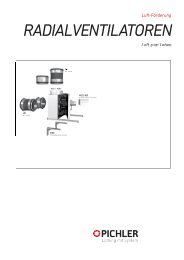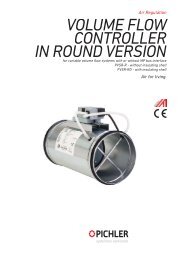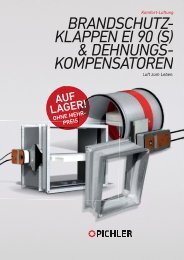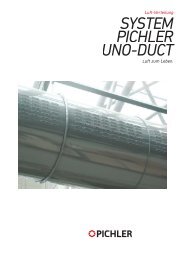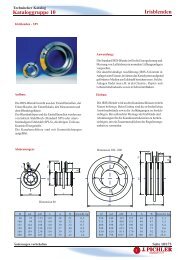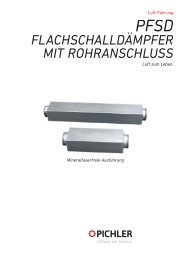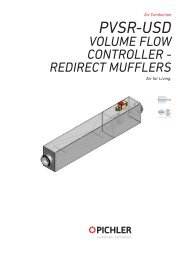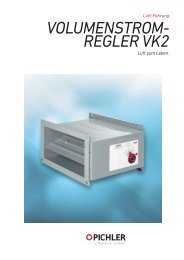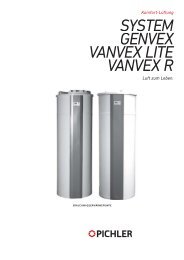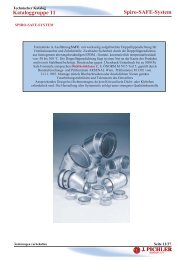PVSR-E volume flow controller_rectangular - Pichler
PVSR-E volume flow controller_rectangular - Pichler
PVSR-E volume flow controller_rectangular - Pichler
You also want an ePaper? Increase the reach of your titles
YUMPU automatically turns print PDFs into web optimized ePapers that Google loves.
VOLUME FLOW CONTROLLER IN RECTANGULAR VERSION <strong>PVSR</strong>-E PAGE 5<br />
Supply<br />
Control variable w<br />
Sensor-<br />
Electronics<br />
A<br />
Q .<br />
Δp Sensor<br />
D<br />
M̂<br />
Δp Microprocessor<br />
z<br />
w<br />
M̂mi<br />
n<br />
M̂ma<br />
x<br />
cw ... ccw<br />
…<br />
Memory<br />
Δp @<br />
M̂ nom<br />
+<br />
–<br />
D<br />
A<br />
Communication<br />
ASIC-<br />
Controller<br />
Halomo<br />
M<br />
U 5<br />
Actual value signal<br />
10<br />
2<br />
0<br />
M̂<br />
PP/MP<br />
DRIVES<br />
In the measurement unit (sensor<br />
electronics), the differential pressure<br />
signal is converted by the sensor to a<br />
signal proportional to the <strong>volume</strong> <strong>flow</strong>.<br />
Control signal w is conditioned in line with<br />
the operational <strong>volume</strong>tric <strong>flow</strong> setting<br />
V min<br />
/ V max<br />
as a target value signal.<br />
The instantaneous offset forms the<br />
control signal for the drive integrated. The<br />
current <strong>volume</strong>tric <strong>flow</strong> is available as<br />
an actual value signal for the display and<br />
control of slave VAV regulators.<br />
+ –<br />
The specially designed runtime logic of<br />
the VAV compact, in conjunction with an<br />
accurate differential pressure recorder,<br />
guarantees high control quality of the VAV<br />
box equipped with it.<br />
A choice between traditional control signal<br />
and MP bus can be made depending on<br />
application.<br />
Δ p<br />
M̂<br />
c<br />
Legend:<br />
V = Volumetric <strong>flow</strong><br />
c = Geometry-dependent constant of the<br />
bluff body<br />
Δp = Differential pressure<br />
= Density of the medium<br />
1.4 VOLUME FLOW MEASUREMENT<br />
The basis for <strong>volume</strong>tric <strong>flow</strong><br />
measurement is a differential pressure<br />
pickup, usually fitted into the air duct in<br />
the form of an orifice gauge, a venturi<br />
nozzle or a differential pressure sensor.<br />
Several measurement methods have<br />
established themselves on the market for<br />
recording <strong>volume</strong>tric <strong>flow</strong>.<br />
Reliable and precise differential pressure<br />
measurement is the key to accurate<br />
<strong>volume</strong>tric <strong>flow</strong> regulation<br />
The measurement used by Belimo<br />
permits reliable mean value calculation<br />
even in unfavourable <strong>flow</strong> conditions.<br />
Every measurement sensor used for<br />
differential pressure recording has its<br />
own dynamic behaviour. The effect of this<br />
measurement body on the <strong>volume</strong>tric<br />
<strong>flow</strong> calculation is referred to as device<br />
constant “c”.<br />
The sensor element comprises a centrally<br />
located heating element with two<br />
temperature sensors positioned in the<br />
<strong>flow</strong> direction. Formed above the heating<br />
element is a temperature bell that is<br />
deformed by the air <strong>flow</strong> in the direction<br />
of <strong>flow</strong>. The resulting temperature<br />
difference between the two temperature<br />
sensors is a measure of the differential<br />
pressure at the sensor.



